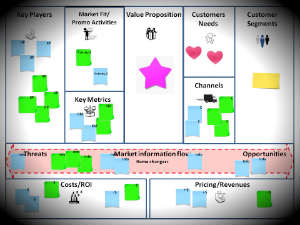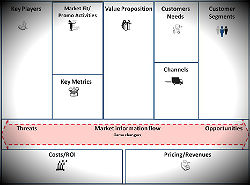
by Rita Baker | Jul 14, 2015 | Lean Startup
Build, Measure, Learn is the Lean Startup mantra. You build an experiment, which results in a minimum viable product. Then you measure the results obtained from your experiment in your market. You learn from these results and decide whether to follow your initial strategy or pivot. The more you repeat this cycle, the more you learn and become efficient at doing it. It sounds pretty simple.
It is actually pretty simple if you apply Lean Startup at the start-up phase. You will acquire the necessary skills and tools as you grow. The culture needed to optimize the build, measure, learn methodology will develop naturally as the organisation evolves. The level of difficulty increases significantly however when you try to implement the Lean Startup methodology in an existing organisation, especially one that doesn’t have a scientific background.
Build
If an existing organisation has the necessary culture and processes in place to accommodate lean startup (this is still a huge if outside of Silicon Valley), building an experiment is usually not a problem. It requires creativity, design thinking and the capacity to get things done outside the box, all of which can be found in most organisations, whatever their size.
Measure
The measuring part gets a bit trickier as it requires analytics as well as market research knowledge and skills that are not as readily found in most organisations.

Learn
This is often where implementing Lean Startup will run aground. The learning part is much more difficult and, in many cases, simply unattainable for existing organisations.
First I’d like to make a distinction between individual learning and organisational learning. In the first case, I’m referring to the learning process of a person. Individual learning, in a work context, often entails replacing existing knowledge with different or more current one. This requires cognitive skills that are more complex than simply acquiring completely new information. Resistance to change mechanisms, amongst others, kick in and make learning more difficult.
In the case of organisational learning, I am referring to the collective memory of an entire organisation. It also pertains to its capability to render all of its accumulated information accessible to anyone who needs it, whenever it is needed, it in a format that is actionable. It can be referred to as business intelligence, information systems or big data.
The challenges with organisational learning, are that not only does it require a corporate culture that values (and invests in) input, output and constant use (by learning and acting on this knowledge) of the information, in larger or older organisations it also requires sophisticated tools, highly specialised training of an important number of resources as well as an entire IT support infrastructure. Unless your organisation has this culture from the outset and gradually builds the skills and tools needed, it is difficult and costly to implement once you are in activity.
Hence existing organisations have a very hard time learning from their experiments and reaching higher levels of efficiency in the build, measure, learn process.
Why would an organisation put itself through such a costly and difficult process? The answer from organisations from organisations that have done so is loud and clear. It is highly profitable. Companies that have started to make information more available to their employees report:
- Faster and freer information sharing between employees
- Better control of internal risks and operation efficiency
- Increased collaboration between business units
- Better response to market opportunities and threats
Amongst many other[1] benefits which translate into higher profitability. If a feasibility study (which not only includes potential revenues but potential losses as well) doesn’t currently show sufficient returns to implement a culture of learning (in most competitive industries it will), make sure to update your data and recalculate your anticipated ROI on a regular basis. Positive results will emerge in the near future.
[1] Source : Economist Intelligence Unit : The virtuous Circle of Data : Engaging Employees in Data and Transforming your Business. – January 2015

by Rita Baker | Apr 7, 2015 | Lean Startup
Starting your own business is a risky proposition. This is the reason getting capital is so costly and difficult. Investors’ goals, at least the ones who are trying to maximise their financial returns, are looking to do so at a minimum risk. Hence getting at the front of the venture capitalists potential candidates line means increasing returns and/or reducing risks. The only way I know how to do both at once is to address your commercialisation risk.
The various risks associated with start-ups
Just about every risk one can think of (even health related ones) can be a concern when starting your own company. The risks an entrepreneur needs to consider are the ones that have a combination of significance of the consequences and likelihood of happening that mean your company’s revenues, or worse its survival, are at risk.
Classifying start-up risks is in itself a risky proposition as various types of start-ups will classify a same risk in different categories. However, with the objective of simplification in mind here are the main start-up risk categories.
Product/Production risk
Can the company deliver a product which lives up to all of its promises in a timely, cost effective, scalable fashion?
Financial risk
Will the company have sufficient funds to develop until it starts getting sales revenue (also known as the runway)? Once it starts selling, will it have sufficient funds to ensure operations, growth and unforeseen expenses?
Managerial/HR risk
Do the founders have the necessary skill set to take the company to where it wants to go? Are the critical functions covered? Is the business model the right one to get optimal growth?
External risks
Have the pertinent political, environmental, social, technological and legal risks been addressed in a fashion that will enable the company to see them coming and take the necessary actions in a timely fashion to mitigate them?
Commercialisation risks
Is the product’s value proposition sufficient to attract buyers? Is the market sufficient to sustain the company’s goals? If the first two questions are answered positively, this is usually the killer question; does your start-up have the abilities to sell its products to its target markets?
The commercialisation risk incorporates many risks that can also be found in other categories. The figure below shows a map of commercialisation risks that should be taken into consideration.  Source: Luoma, T., Paasi, J. and Nordlund, H. (2008), Managing Commercialisation Risks in Innovation Development: Linking Front End and Commercialisation, In Proc. of The XIX ISPIM Conference.
Source: Luoma, T., Paasi, J. and Nordlund, H. (2008), Managing Commercialisation Risks in Innovation Development: Linking Front End and Commercialisation, In Proc. of The XIX ISPIM Conference.
How the Lean Startup approach reduces the commercialisation risk
Lean Startup strongly advocates getting to know your market before you develop your product. You start by having a business idea; you quickly identify the underlying hypotheses of your idea and then devise an experiment where your minimum viable product (MVP) will test the validity of these hypotheses. Inevitably, at one point in your series of experiments, you will need to test the hypothesis that your market is willing to pay money for your product i.e. you can sell. Later you will need to test that you can scale your business idea to a level that is sustainable, i.e. sell enough to sustain your business. These experiments, that are meant to collect the most information with the least effort in order to get you to your product/market fit, are the embodiment of reducing your commercialisation risk.
Other practices encouraged in Lean Startup are to take the time to properly define your value proposition, methodically collect data to validate your market hypotheses and understand the cues from your market. Use management tools, such as the Business Model Generation, adapted to the start-up environment. All of these Lean Startup practices are meant not only to ensure you know how to sell your product but also to reduce your various start-up risks.
There is a reason why venture capitalists are, not only taking notice of start-ups using the Lean Startup methodology, but increasingly encouraging it, it makes their job easier.

by Rita Baker | Mar 25, 2015 | Lean Startup
Si l’approche Lean Startup est moins connue au Québec auprès des entreprises en démarrage, elle l’est encore moins dans le secteur municipal. Bien qu’il y en ait certainement au Canada, aucun média ne rapporte de projets municipaux utilisant cette approche Lean Startup. L’initiative de données ouvertes de la ville de Montréal semble avoir emprunté certains aspects du Lean Startup à ses débuts en 2011 mais le projet semble être au ralenti depuis (1).
On doit regarder à l’extérieur pour trouver des exemples concrets d’applications de l’approche Lean Startup à des projets municipaux. On retrouve de exemples en Suède, en France ainsi que plusieurs aux États-Unis. Pour ce billet nous examinerons le projet de refonte du site web de la ville de Palo Alto en Californie, piloté son CIO, Jonathan Reichental. M. Reicheenal a également géré de nombreux projets reliés à la mise en place d’une plateforme de données ouvertes pour la ville en utilisant l’approche Lean Startup.
Reichental est entré au service de la municipalité de Palo Alto à la fin de 2010. Son premier projet était de refondre le site web de la ville mis en ligne en 2008. Le site web n’atteignait que peu de ses objectifs initiaux et était vertement critiqué par les citoyens. Ces derniers, ainsi que les médias locaux, sont très volubiles sur l’administration municipale et, en raison de leur proximité à la vallée du silicone, ont une connaissance supérieure à la moyenne des technologies web. Ces critiques déteignaient de plus en plus sur l’image de la ville. Il y avait donc urgence à redéployer un site mieux adapté aux besoins et attentes des citoyens.
M. Reichental a donc proposé d’appliquer l’approche Lean Startup, qu’il avait utilisé précédemment dans le secteur privé. Cette approche lui permettait de livrer une nouvelle version du site rapidement tout en s’assurant que les besoins des citoyens étaient, non seulement pris en compte, mais la base sur laquelle tous changements seraient fait.
L’équipe de fonctionnaires municipaux en place était loin d’être convaincue qu’une telle approche fonctionnerait dans leur environnement. Ils craignaient que les citoyens et médias locaux critiquent les versions préliminaires du site et détractent le projet avant même qu’il puisse être complété. Ces inquiétudes étaient loin d’être frivoles puisqu’on observe régulièrement de tels scénarios dans le secteur privé.
La façon éprouvée de réduire ce risque s’est avérée être une communication transparente et soutenue du processus, et, de l’état d’avancement du projet. L’équipe de communications municipale a donc été intégrée dès le départ et un site web a été créé pour le projet. Ce site permettait non seulement de regrouper toutes les informations officielles sur le projet au même endroit, mais il permettait également de recruter des citoyens volontaires pour tester les diverses fonctionnalités déployées et l’ergonomie des nouvelles pages. Les citoyens y avaient également un forum où ils pouvaient échanger entre eux et avec les responsables du projet. Ils pouvaient également s’abonner à un compte Twitter qui les informait de tout ajout sur le site.
La municipalité a donc pu, en à peine 3 mois, mettre en ligne une première version améliorée de son site web. Plusieurs itérations ont suivi et la ville effectue maintenant des modifications, surtout mineures, à son site de façon régulière plutôt que de grandes refontes périodiques. La majorité des modifications sont faites suite à des réactions de citoyens sur le forum dédié au site web de la ville.

Les retombées positives non-anticipées
De nombreuses retombées positives importantes de l’utilisation de l’approche Lean Startup n’avaient pas été anticipées par Palo Alto.
La première est que les médias ont mis beaucoup d’emphase sur la transparence de l’administration dans la gestion de ce projet. Ils y voyaient une amorce d’ouverture pratique, plutôt qu’au niveau du discours, de l’administration.
Toute critique au design du site, ayant généralement déjà été adressée dans le forum, avait une réponse plausible. Les journalistes avaient donc peine à présenter les lacunes sous un angle uniquement négatif sans se faire rebiffer dans les médias sociaux par les citoyens impliqués.
La presse s’est donc mise à rapporter principalement les ajouts et améliorations au site de la ville plutôt que de mettre en lumière ses lacunes.
La seconde retombée positive est que le gabarit et les applications développés pour fin de communications et de tests pour le projet du site web ont pu être réutilisés pour de nombreux autres projets où la municipalité désirait impliquer les citoyens. Cela a grandement accéléré le déploiement de projets subséquents.
Une autre retombée positive est que les citoyens les plus critiques face au site web ont été, en majeur partie, les plus impliqués dans le forum et les tests. Leurs implication a permis de trouver des solutions souvent moins coûteuses et plus efficaces. De plus, les critiques non fondées étaient mis en lumière dans le forum. Ce qui avait généralement pour effet de calmer les ardeurs de leur auteur.
Les responsables des communications de Palo Alto ont remarqué qu’ils ont reçu moins de demandes d’informations sur le projet et qu’il y avait significativement moins d’erreurs dans les médias sur les informations s’y rapportant. Les journalistes n’avaient qu’à se rendre sur le site web du projet pour y trouver l’information juste. Si une mauvaise information circulait, un citoyen informé s’empressait de référé l’auteur au site pour corriger le tir.
Les fonctionnaires de Palo Alto impliqués dans le projet ont rapporté avoir une meilleure compréhension des besoins des citoyens et ressentir également un rapprochement tangible entre la population et l’administration.
Finalement, sur le plan politique, l’administration en place a bénéficié de nombreuses gourdes commises par le parti d’opposition, qui semble-t-il ne prenait pas la peine de suivre les développements sur le site. Ces gourdes, étant facilement identifiables par les citoyens en raison des informations sur le site du projet, ont contribué à ternir l’image du parti de l’opposition. L’histoire ne relate pas les résultats des élections subséquentes.
Les difficultés de la méthodologie Lean Startup
L’approche Lean Startup comporte de nombreux avantages mais rien n’est parfait. Son implantation, dans toute organisation, vient avec certains obstacles à franchir. Ces obstacles, comme l’expérience de nombreuses municipalités le démontre, ne sont pas insurmontables mais, ils doivent être pris en compte avant le départ de la course au risque de s’y casser le nez.
Les méthodes de gestion de projet des employés de Palo Alto ont dû changer de façon drastique. Non seulement la volonté de partager l’information devait-elle dorénavant exister mais des mécanismes ont dû être mis en place pour accommoder cette nouvelle exigence. Il en est de même pour faciliter la collaboration des effectifs des divers départements. L’appui, le renforcement, l’influence et la motivation soutenu du CIO, M. Reichental, ont été déterminants dans le succès de ce projet.
Le site web du projet étant le hub des communications, une attention particulière devait être portée à l’exactitude des données qui y étaient déposées. Toute erreur devait être signalée aux usagers et corrigée rapidement sans quoi les efforts de communication décuplaient.
Aucune donnée comparative n’a été compilée quant aux coûts des projets municipaux utilisant l’approche Lean Startup vs une approche traditionnelle. Les experts qui ont observés et participés à divers projets s’entendent par contre pour dire que l’approche Lean Startup n’est définitivement pas moins coûteuse et est probablement plus coûteuse que l’approche traditionnelle pour le premier projet. Les gains se font à l’utilisation répétée de l’approche et en tenant compte du gaspillage de ressources évité.
L’approche Lean Startup demande un effort de communication significativement plus grand qu’une approche traditionnelle où on informe la population uniquement lorsque le projet est terminé.
L’approche Lean Startup dans le secteur municipal requiert un très grand niveau de transparence publique. Ce ne sont donc pas tous les projets qui peuvent s’y prêter. Non seulement doit-on exclure les projets où la confidentialité est un élément important mais également les projets demandant un niveau de connaissance élevé de la part des citoyens. Si les éléments d’un projet ne peuvent être communiqué de façon à ce que le citoyen moyen puisse comprendre il vaut mieux utiliser une forme adaptée du Lean Startup où les informations ne seront communiqués qu’à un groupe limité.
L’approche Lean Startup est toute indiquée dans les municipalités qui désirent minimiser le risque d’échec de leurs projets et accroître la transparence de leur administration.
(1) Une annonce doit être faite sous peu à ce sujet par l’administration Coderre.

by Rita Baker | Mar 16, 2015 | Lean Startup, Ville intelligente
Nous avons identifié, dans un précédent billet de cette série, les types de projets qui bénéficient d’un effort marketing de la part de la municipalité pour augmenter le taux d’adoption par les citoyens.
Fréquemment, les responsables de projets municipaux sont tellement convaincus que les citoyens adopteront le nouveau service qu’ils ne mettent en place aucun mécanisme pour s’assurer de maximiser le taux d’adoption par la population. En pratique, l’effort se limite généralement à communiquer l’existence du nouveau service et de l’incorporer au site web de la municipalité.
Pourquoi investir dans la maximisation du taux d’adoption d’un service municipal?
Pour de nombreux projets municipaux le taux d’adoption est un des principaux jalons de la rentabilité socio-économique du projet. Son importance ne s’arrête pas là. Lorsqu’un projet s’implante en plusieurs étapes, atteindre les niveaux attendus d’adoption, à chaque étape, permet de conserver le momentum du projet (et se faire attribuer des budgets pour sa poursuite) et parfois même éviter son annulation.
Au niveau politique, on désire évidemment éviter qu’un nouveau service soit perçu comme un ‘’éléphant blanc’’ par la population.
Plus un nouveau service municipal est novateur, plus son taux d’adoption naturel (celui sans efforts marketing) sera faible. Les raisons de ce fait sont multiples mais se résument grossièrement à : La grande majorité des gens n’aiment pas le changement (même si plusieurs disent aimer on observe l’inverse dans leurs actions).
Comment maximiser le taux d’adoption d’un service municipal?
Il n’y a, bien entendu, plusieurs façons d’arriver à nos fins. Je vous propose ici une façon de faire qui s’inspire de la méthodologie Lean Startup . Cette méthodologie, basée sur de multiples théories existantes (dont le lean manufacturing, le développement agile, le design thinking et d’autres) a fait ses preuves dans les entreprises en démarrage, les grandes entreprises telles General Electric et à la Maison Blanche. La méthodologie Lean Startup s’adapte aussi très bien au contexte municipal, et ce, peu importe la taille de la municipalité.

La méthodologie Lean Startup se résume, en gros, à trois étapes.
- Construire un prototype minimaliste du service qui permet à l’utilisateur de juger de sa valeur à partir de nos hypothèses de départ
- Mesurer l’attrait de notre service, de façon rigoureuse, auprès de nos clientèles cibles
- Apprendre des informations recueillies auprès des utilisateurs et construire une seconde version améliorée du prototype ou effectuer les changements nécessaires à la clientèle visée ou au service
Répéter les étapes 1 à 3 jusqu’à ce que le service soit optimal du point de vue de nos clientèles cibles.
L’approche est simple. Sa mise en application requiert par contre un changement radical de culture dans la majorité des organisations qui l’adopte. L’organisation qui adhère à la méthodologie de Lean Startup doit épouser et adopter les valeurs et façons de faire suivantes:
- Toute action qui est entreprise doit l’être dans le but d’apporter (directement ou indirectement) de la valeur à sa (ses) clientèle(s) cible.
- L’erreur est non seulement tolérée mais nécessaire au processus d’apprentissage (dans la mesure où on ne refait pas la même erreur deux fois)
- Les changements d’orientation fréquents (afin de s’ajuster aux besoins de nos clientèles cibles) font partie intégrante de la méthodologie
- Les mécanismes nécessaires à la prise de décision, basée sur des données concrètes, doivent être mis en place
- Les décisions sont basées sur des données mesurées de manière rigoureuse
Pourquoi les organisations qui ont adopté l’approche Lean Startup se sont-elles astreintes à mettre en place cette façon de faire? (1) Simplement parce qu’elles ont pu constater, en initiant d’abord de petits projets, que le taux de succès et d’adoption de leurs produits et services novateurs décuplait en utilisant cette approche. L’approche Lean Startup assure que tous produits ou services mis en marché répondent aux besoins du marché cible. Si tel n’est pas le cas, le lancement ne se fait tout simplement pas. On diminue ainsi le gaspillage de ressources.
Dans un prochain billet nous verrons un cas pratique d’un projet municipal de création d’un service novateur qui utiliserait l’approche Lean Startup.
(1) Il est intéressant de noter également que dans les cas de GE et de la Maison Blanche, l’approche Lean Startup a été adoptée en utilisant une méthodologie Lean Startup. L’approche a été utilisée avec des projets tests puis étendue graduellement à d’autres projets de plus grande envergure dans les organisations. Les mécanismes mis en place pour accommoder la méthodologie ont été diffusés d’un département à l’autre et le changement de culture se fait naturellement dans la mesure où il est appuyé par la haute direction.

by Rita Baker | Feb 25, 2015 | Lean Startup
In previous posts (part 1, part 2 and part 3), we saw what the MVP marketing plan was about and went into details about each box. The MVP marketing plan is a quick way to plan, organise and keep track of your MVP marketing activities. These activities include any and all of the market experiments you will be doing to find your product/market fit.
Before you start filling out the boxes of the MVP Marketing plan you will need to gather some information.
Setup – First version of your MVP

If you are at your first version of your MVP then you’ll need to sit down and do a proper mini-marketing plan. The content of this plan will vary according to your type of business, your product or service and the market(s) you are going after. The basics you will need to cover are the following;
- Target market
- Who will be buying your offerings (hypotheses, customer profile, persona, etc.)?
- What are the needs of your buyers that your product or service will answer?
- How do you define your market segments?
Approximately how many customers do you realistically think will buy your offerings in each segment (what hypotheses, market information and math are you using to get to these numbers?)
- Product or service
- What is your product or service?
- How will it better answer the needs of the buyers you are aiming for than how they are satisfying their needs right now?
- Customer experience
Map out the entire experience your customers will have while interacting with your organisation and your product, or services.
At each touch point, flesh out a typical interaction. This exercise takes a while. Once you are done with it however, I guarantee you will have insights for every single aspect of your MVP marketing plan that will not only accelerate future decision making exponentially, it will enable you to make better decisions all around.
This is also where you will figure out your various customer service needs (admin. and tech.).
- Price
How much does it cost to produce each unit of product or service? Here you will calculate all of your expenditures, including any that you are not dishing out hard cash for during your calculation period but will need to eventually, and divide it by the conservative estimate of number of sales you will have during a period that makes sense for you (*). The number you get plus what you consider a reasonable profit margin should be the very lowest price you charge for your product or service. If your target market cannot bear your minimum price, you need to find a way to reduce this number before hitting the market with your MVP or find a new target market.
This is where you need to itemise all of your current and forecasted expenditures, if you haven’t done so already. Accounting can be tedious but it is essential to master it from the get go if you want your organisation to survive after your runway (**) runs out.
Forecast your sales revenues, number of sales and costs on a weekly or, at minimum, monthly basis.
- Distribution
List all of your distribution channels and the people you will be dealing with to run these channels for each MVP. If some of these channels will not be available at all times, make a calendar and sketch out which channels will be available when.
It is important to go into detail with your distribution channels. If you sell with the help of a face to face sales team (even if its friends/family who are not being paid), on the web, via your own web site, an Amazon store and via referrals on 5 other sites, you need to do the exercise for all 8 distribution channels.
Furthermore, if you use logistics suppliers (web or brick & mortar based), you need to include them in this section of your plan. They are key parts of your distribution channels and will also be impacted when you start doing promotions or marketing-communication activities.
- Promotion
Jot down ideas as to how you will get your market feedback for your next few iterations of your MVP. Also include any promotional/communication activities you will need for funding purposes. Finally, if you are anticipating any activities to get your brand out there, also include them here.
If you’re not at your first MVP iteration – Download canvas

Gather all the information described above and organise it so you, and the rest of your team, have easy access. Complete any missing information.
You can download a MVP marketing plan canvas pdf here. You can also find larger images of a canvas and a full MVP marketing plan.
Sticky notes. Sticky notes everywhere
Now that you have the basic information you need, this is the material required  to start using your MVP marketing plan
to start using your MVP marketing plan
- Poster board (22’’X28’’ or larger). Optional
- Sticky notes (as many colours as you have activities or customer segments)
- Pencil
- Brains (preferably with accompanying bodies), as many as you can gather
Draw the boxes of the MVP marketing plan on your poster board. Hang it on your office wall in an easily accessible and very visible place.
You also can draw the MVP marketing plan directly on the wall if you can stick notes on the surface.
Colour-code your marketing activities, if you will be running more than one for each MVP iteration, or your market segments (if you chose to have one board per activity), by using a same sticky note color for each of them.
Write a single idea on each sticky note. It may be hard at first to summarise your entire idea so that it will fit on one side of the sticky note. You will get very good at it with time.
If you are good at drawing, you can also draw out the idea. You can also use pictures or any other means of visual communication that you can somehow stick on your MVP marketing plan that will get the message across.
Your ideas will usually pertain to a single topic on the plan. Before you start to write your idea, you can put the initial of the box it will be stuck on in a corner of the sticky note. This will make using the notes in the future much easier and it also helps to know where to stick it back when a note falls to the ground.
If your sticky note pertains to more than one of the boxes, simply write the initials of all of the boxes the topic pertains to and stick it on the board where it makes the most sense.
Keep a supply of sticky notes and a pen near the poster board. You can even make a hole on the board, put a cord through it and hang a little pouch or plastic bag that will hold your supplies.
The more you use your MVP marketing plan, the more you will find ways to make it work for you. You will inevitably forget to put some of your ideas on the board. No worries, just stick the missing note on it when you think of it. It will usually take you less than 30 seconds to do so. Like any other management tool, it takes a certain amount of discipline to use it. Fortunately the MVP marketing plan is the management tool that requires the least amount of discipline that I know of.
Don’t throw it out
Finally, when you are done with a specific marketing activity, or you’re at your fourth layer of sticky notes on the board, put the notes in an envelope or folder clearly marked with the name of the activity as well as the weeks, month(s) and year during which the activity ran.
These notes will be very useful when you’ll need to write out a full marketing plan. It will also help you see your evolution over time or specific patterns emerging. Sometimes, it will even remind you of really good ideas you had in the past.
If you have any questions on how to use the MVP marketing plan you are welcome to contact me.
Finally, as I’ve been using this tool for my own business and with my customers it is becoming apparent that a digital version of the MVP marketing plan that would allow the following would be awesome.
- Fast recording of the visual notes (by all contributors), with an option to tie the notes to additional material
- Collaboration features that enable discussion before posting a note
- Permanent viewing/projection of a real-time board in a single or multiple locations
If you feel like this is a project you would be interested in for your own business, please contact me.
(*): If you can find average profitability margins for your sector you can go with those.
(**): A runway is the period of time a start-up has before it starts to generate sufficient revenue to cover all of its expenses.
Techno Marketing fait relâche jusqu’à la mi-mars.
Techno Marketing is taking a break until mid-March.
EDIT (Sept. 2016) – Added a link to download a pdf of the canvas

by Rita Baker | Feb 17, 2015 | Lean Startup
In the previous post of this series on the MVP marketing plan we looked at the value proposition, customer needs, customer segments, market fit/promotional activities as well as the distribution channels on the MVP marketing plan.
We will now look at the rest of the elements that compose the MVP marketing plan.
 Key players
Key players
The key players are all the actors, internal and external that will need to be involved with the marketing activity you are using the MVP plan for. This box of the plan can be used to identify the resources you will need for your marketing activity. It can also be used to keep track of the order in which key players will be needed as well as their level of involvement. Any major issues with key players that may hinder their performance or capacity to deliver can also be noted in this box. If you are familiar with project management techniques you can use a RACI (responsible, accountable, contribute or inform) designation to instantly see the relative importance of the players at any given time during the activity.
A side benefit of this box is to easily see the load on your resources so you can prioritise or re-balance workloads in order to keep delivering on time.
 Key metrics
Key metrics
The key metrics are the data points you will be collecting and analysing to ensure that you are reaching the goals you have set for specific marketing activities. A key metric can be anything from analytics data to survey answers or observations you have noted. In the Lean Startup methodology key metrics are the heart of the measure part of the Build – Measure – Learn triad.
In traditional marketing, it’s the control part of marketing management. It is what tells you if you are going forward, backwards or sideways relative to your goals. Without it, you are blind to any progress or missteps. If a significant portion of your goals pertains to web activities, web analytics data will be the major (if not only) source of your key metrics. If this is your situation and you don’t have the internal expertise to gather and analyse web analytics data, I urge you to get external help while you crash learn about it.
 Pricing and Revenues
Pricing and Revenues
This is where you look at your pricing strategy for your marketing activity and the revenues you anticipate from it. Although the revenues from marketing activities are not always hard cash coming into the till, they should always be converted in $ (or whatever your local currency is). This, so you can figure out the return on your investments from the marketing activity you undertook. You will also need to compare your activities in term of ROI and see which types are the most valuable.
If your marketing activity impacts your pricing (discounts, promotional prices, new price category is created, etc.) this box will allow you to keep track of your pricing strategy and help you avoid, ‘’boxing yourself into a corner’’ price-wise, or other pricing issues that can creep up when your do multiple promotional activities that impact your pricing.
 Costs/ROI
Costs/ROI
This is the financial part of your marketing activity. You need to look at all the costs involved and compare them to the revenues expected to figure out your return on investment (ROI). The ROI is what will tell you whether or not you should go forward with your activity. Just like any other project, a marketing activity should never be undertaken if you don’t expect it to be profitable. It’s normal to not be good at forecasting your costs and revenues at first as you don’t have experience. It is essential that you keep at it and learn. Otherwise your marketing expenses can become a budgetary black hole that will engulf your entire business. On the flip side you can become so traumatised by allocating marketing budgets and never seeing returns that you will cease all marketing activities. In either case the end results will be deadly to your business.
Comparing the ROI from one activity to the next can also help you prioritise and spot the types of activities that are the most profitable for your business. In order to use this box in such a way, you will need to update your ROI information once your activity is completed as your real costs and revenues will differ from the projected ones you used to decide whether the activity was a go or no go.
Market Information Flow
This element is one of the more innovative aspects of the MVP marketing plan. Although every business knows market information is needed to operate, most of them do not realise the importance of allocating permanent resources to collect, analyse and diffuse information throughout the company. If you are going to operate in a fast moving market, (most markets that are not heavily regulated or deal with extremely high priced goods or services now fit this category) you will need to have your ear to the ground to hear threats, opportunities and changes in your customers’ need coming. A failure to see any of this can result in death or near death experiences for your business.
Businesses have always collected market information. It was usually the responsibility of the marketing team. The internet has since made the amount of available market information so huge that it is impossible for only a few people to gather, filter and use the pertinent information. This is why the market information conduit must go through every department in a company, ideally in real-time. Every single resource must be a gatherer and a user of market information as it pertains to their main task.
In the context of the MVP marketing plan, the market information flow element serves as a bulletin board where anyone who gets wind of information that could affect any aspect of the marketing activity itself can bring it forward so the adjustments can be made.
In the end, the market information flow box represents what being an entrepreneur is all about. You make a plan, shit happens and you have to deal with it quickly. In more elegant terms, being a successful entrepreneur is more about how fast you learn and react to those learnings than what you already know.
In our fourth and final post of this series we will take a look at ways to use the MVP marketing plan.
EDIT – Sept 2016 – Link fixes and pictures














 Key players
Key players Pricing and Revenues
Pricing and Revenues Costs/ROI
Costs/ROI